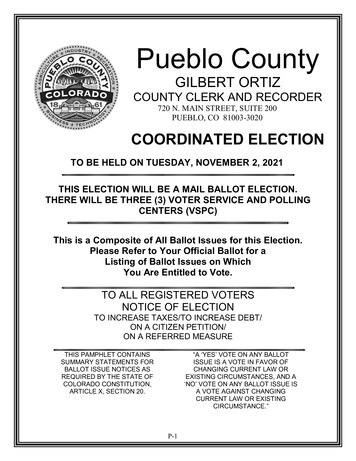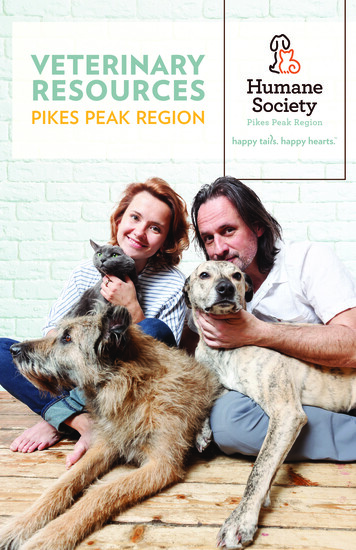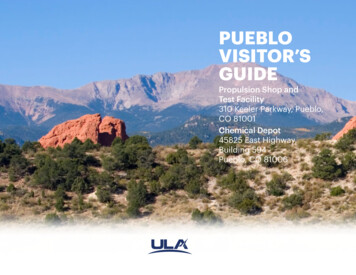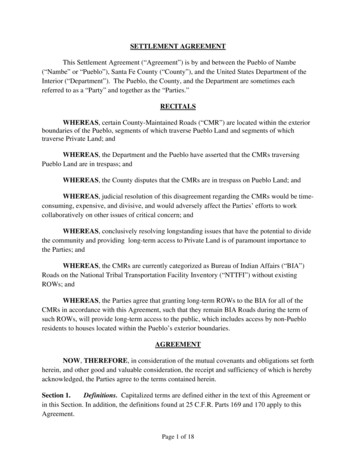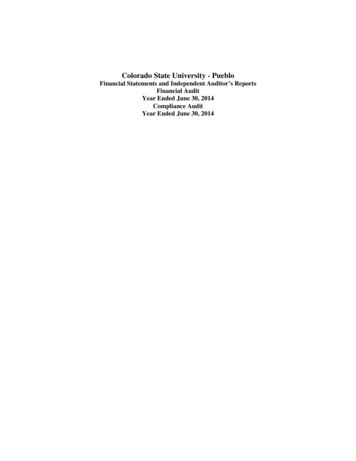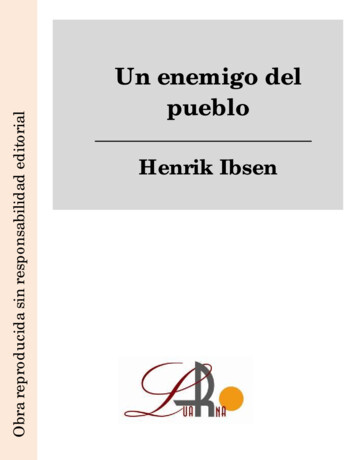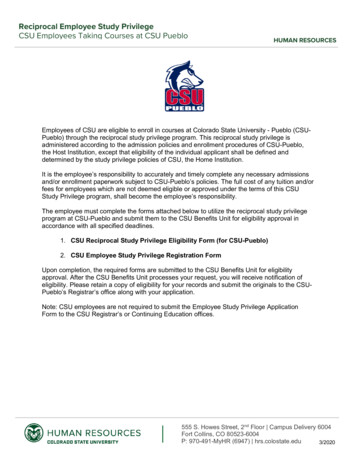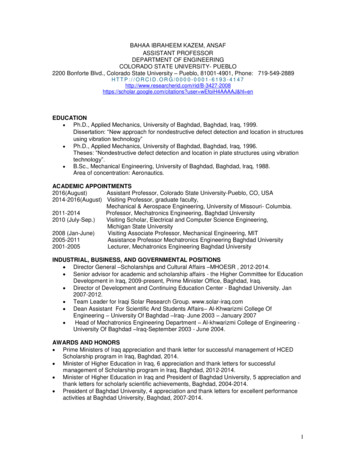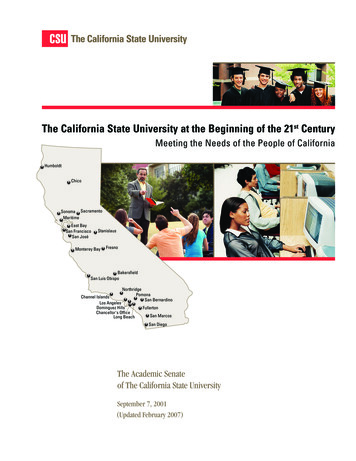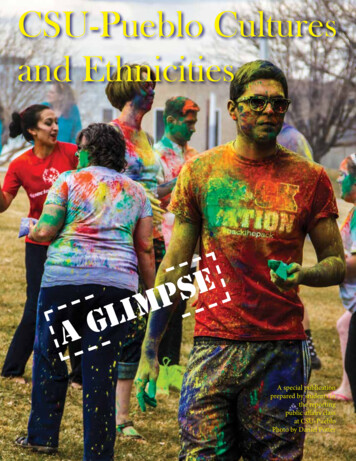
Transcription
CSU-Pueblo Culturesand EthnicitiesAespmiGlA special publicationprepared by students inthe reportingpublic affairs classat CSU-PuebloPhoto by Daniel Potter
2Reporting Public Affairs 2015Index of storiesCSU-Pueblo demographics show increased diversity . 2Overcoming language barriers and adjusting to the United States . 6Student campus involvement reflects Hispanic roots .9Small town students meet big time college experiences . 12International program educates campus by bringing diversity . 14Athletics is a culture . 18Some student profiles . 20The staffKierren Duncan, Co-EditorThe students in the 2015 springreporting public affairs classexamined some of the culturesand ethnicieties at CSU-Puebloand this publication is the result. While it wasn’t possible tocompile a comprehensive report,the editors hope this glimpsewill illistrate the rich and diversepopulation on campus.Michelle Pham, Co-EditorGianna Lisac, Co-EditorKiersten Senff, Co-EditorRichard A Joyce, Adviser
Cultures & Ethnicities at CSU-PuebloColorado State University-Pueblo cheerleaders drive gameday bass drum around downtown Pueblo during the “Celebration ofChampions” back in February 2015.Photo by Jessica Warren.3
4Reporting Public Affairs 2015CSU-Pueblo demographicsshow increased diversityBy Kiersten SenffCo-EditorThe Colorado State University-Pueblo campus community hasa more diverse range than mightbe expected, considering the censusstatistics of the state of Colorado, which show that of the over 5million people estimated to be inColorado in 2014, 88 percent ofthem identified as being white.In comparison, the 2014 FallCensus on the CSU-Pueblo campus showed a population of 4,528students, and of those, 49.9 percentof them were white. This meansCSU-Pueblo has a more diversepopulation than does the state ofColorado.Almost half of the studentpopulation in fall 2014 was white.The other large population herewas Hispanic, at 31 percent of thestudent body.Even with recruiting from the foreign exchange program, only about3 percent of the student body ismade up of exchange and international students.That’s about 135 students ranging from countries as diverse asFrance, Germany, Korea, Italyand many more. Every semestersomewhere around a dozen of ourstudents exchange with studentsfrom other countries.Some of the other smaller demographic groups include African-Americans, with currentlyabout 7.4 percent of the campuspopulation, Native Americans with.6 percent of the population andIslanders with .1 percent of thepopulation on campus.These numbers have not changedmuch in the last few years. In fall of2009, according to the CSU-Pueblo Fact Sheet, the total populationon campus was 4,728 with themajority demographic still beingwhite, at 55 percent.Hispanic demographics were thesecond largest group in 2009, justas now, but constituted 25 percentof the population. Since that timeidentify as white, African Americanand Hispanic you will be countedas Hispanic. And it is all self-reporting,” said Kreminski.This change happened sometime in 2008 or 2009, whichwould explain the rise in numbersof Hispanic students coming toCSU-Pueblo.Another change on theCSU-Pueblo campus is a rise from2.2 percent of the foreign exchangeand international demographics toits current 3 percent.“Our percent that is Hispanicwent up because the federal guidelines were expanded. If you identifywith multiple ethnicities you will becounted as Hispanic.”—Rick Kreminskithe Hispanic population has beengradually rising while the whitepopulation has been decreasing.“Some of that is there was apoint where how people reportbeing Hispanic changed. It’s moregeneral now,” said Rick Kreminski,provost and executive VP for Academic Affairs.“Our percent that is Hispanicwent up because the federal guidelines were expanded. If you identifywith multiple ethnicities you willbe counted as Hispanic. So if youUnfortunately, CSU-Pueblo alsoexperienced a loss in some of theother demographic areas. This maybe attributed to the 200-person lossin enrolment from 2009 to 2014.In 2009, there was a 9 percentpopulation of African-Americansand 2 percent for Native Americans.When the total population wentup in the fall of 2011 to 4,960 students the campus saw a small influxof people in the Hispanic demographic reaching 28 percent and a
small reduction in the white demographic dropping to 53 percent.Along with gaining those students, more may have self-reportedto identifying as being multiple ethnicities, including Hispanic, whichwould count them as Hispanic onidentifying documents.Cultures & Ethnicities at CSU-Pueblo5The African-American populaNSE Coordinator Heidi Laino saidtion dropped another percentage to the center sends professional staff to8 percent, and Native Americansother countries to recruit studentsdropped to 1 percent. The foreignfor CSU-Pueblo. That may accountexchange and international popula- for the slight rise in foreign extion rose slightly to 2.4 percent.change and international studentsAssistant Director at the Centerover the years.for International Programs andColorado State University-Puebloethnicities
6Reporting Public Affairs 2015Overcoming language barriersand adjusting to the United StatesBy Kiersten SenffCo-EditorLanguage barriers can be difficult to overcome when speakingwith someone you may not fullyunderstand and who may not fullyunderstand you. At Colorado StateUniversity-Pueblo there is an exchange and international programthat gives students a place to go sothey can be understood and given achance to acclimate to our country.When new students come herefrom other countries, to learn, theymust first show they can speak English well enough to take universityclasses. The test that measures thisability is called TOEFL. It standsdoes not have any history in speaking English, he or she is put in theELI or English Language Institute.In the span of a year students aretaught or given a refresher on howto speak English so they can startworking toward a degree.Laino’s job is to help new students coming to this country feelcomfortable and get them acclimated. “We register them and helpthem to get situated with a cellphone and shampoo. So we takethem shopping in the first two orthree weeks. We are always happyto have volunteers to help us getthem settled in,” Laino said.Having someone who speaks yournative language is very comfortingThe hardest part, a lot of international students say, is that in thiscountry, if people know students areforeign or from another country butdon’t know if they speak English,those people just ignore them.—Heidi Lainofor Test of English for Foreign Language, according to Heidi Laino,the assistant director at the Centerfor International Programs andNSE Coordinator.A student must score a 61 on theTOEFL exam to be able to takeclasses at CSU-Pueblo. If a studentto students when they first arrive,Laino said. The hardest part, alot of international students say,is that in this country, if peopleknow students are foreign or fromanother country but don’t know ifthey speak English, those peoplejust ignore them. Americans aren’topen to them and they feel securein their little groups of people fromtheir own country.Hee Choi, sophomore geophysicsmajor, came to CSU-Pueblo fromSouth Korea. When asked what thebiggest adjustment for her was, shesaid, “Carpets in our rooms.” Witha laugh she explained that in SouthKorea people take their shoes offbefore entering a house so there isno carpet, and all of the floors areheated.The second hardest thing toadjust to was our food. “Everythingin America is always fried,” saidChoi. Choi will only be joiningCSU-Pueblo for this spring semester, but she was given this opportunity by her professor in Korea,who offered to sponsor her to studyabroad.Another job Laino is tasked withis getting applications and calculating the grade point average ofincoming students because othercountries have a different grading system that may go either bypercentage or numbers, so she mustlook it up in her database and seewhere they are from and what thegrading system is and then evaluatethem accordingly.Coming to a new country andlearning new culture can be anadjustment. Each country has itsown set of quirks and customs. TheInternational program is alwayslooking for volunteers to help makethe transition easier on studentscoming here from another country.The programe also hires students
who have been accepted for workstudy as communication partnerswho will speak to the students andshow them around campus to feelmore welcomed.“I have only met with a conversation partner two times, but it isCultures & Ethnicities at CSU-Pueblo7helpful,” Choi said. “It gives meThose interested in becomingsome confidence. In countries likecommunication partners or helpingSouth Korea, children are taughtthe international program either asas young as 8-years-old to read involunteers or work-study studentsEnglish, but they may not get a lotmay contact Heidi Laino at theof practice speaking it before theyinternational office in the OUC.come here.HelloHolaMerhabaSalaamÜNamaste HalodvözlömOhayoHalloOlâCiaoSYah SahsNay HohAhojMarhabaHejziaBonjourJambo Ní Hâo
8Reporting Public Affairs 2015Students participate in the university’s Celebrando a la Mujer festivities in 2015, which included folklorico dancing and traditional Hispanic mariachi music.Photo by Jessica Warren.
Cultures & Ethnicities at CSU-Pueblo9Student campus involvementreflects Hispanic rootsBy Gianna LisacCo-EditorColorado State University-Pueblo has been rooted in furtheringeducation within the SouthernColorado community.For several decades, Pueblo’s richHispanic history has been evidentacross campus.According to the university’sMulticultural Council, the top levelof administration is committed todiversity and takes pride in enhancing the cultural, linguistic, andeconomic backgrounds of not justHispanic students, but all studentson campus.Since The university took theinitiative to become a HispanicServing Institute, multiculturalism has become a cornerstone ofthe university’s mission, and hasallowed for the genesis of severalculturally based organizations.In 2002, the Department ofEducation named the university aHispanic Serving Institution.With at least 25% of the studentpopulation identifying as Hispanic-American, the university became eligible for additional federalgrant aid.In the university’s fall 20104 census, 1,405 of 4,528 students identified themselves as Hispanic.Today, Hispanic culture is prevalent on campus. Several groupsincluding Movimiento EstudiantilChicano de Aztlan (M.E.Ch.A.),the Society of Mexican/AmericanEngineers &Scientist, Mujeres Uni-das de CSU-Pueblo, and the BalletFolklorico exist on campus.These groups allow the opportunity for students who identifyas Hispanic-American to becomeinvolved on campus, while still acknowledging their ethnicity.Organizations such as these function to include Hispanic students incampus events and to enhance thecampus-wide cultural diversity.According to the university’sPackLink website, M.E.Ch.A. is anational student movement thatstemmed from the nationwide Chicano Movement in 1969.The group exists to support thecampus’s Chicano Studies department.The organization is politicallyfueled and guided by principles ofthe Hispanic culture, while enhancing the campus community andpromoting relationships with members of other ethnicities as well.Folklorico exists to preserve andpromote diversity on campus withcultural awareness.The group does so throughperformances, presentations andprograms centered on the traditionof Mexican folklore Dance.The PackLink website states thatthe group aims to provide opportunities for association and interaction not only on campus, but theextended community as well.The Latino Students Unidos is acampus organization that organizespanels, events, educational and networking opportunities to enhancethe success and diversity of localLatino students, as stated on thePackLink profile.The group offers students academic and career-related advice intheir study throughout the community.LSU seeks to build a bridge forLatino students to ease the transition between being classroomstudents and transitioning into theprofessional world.The university’s commitment todiversity is visible annually, as ithosts Hispanic Heritage Month.Festivities include Dia De LosMuertos (Day of the Dead) Altars,as well as Aztec and Folkloricodances.Hispanic Student life has played arole in the dynamic of the campusatmosphere.Student Freddy Correamanriquehas attended the university for fouryears, and is involved in severalstudent organizations.Correamanrique participatesin the Associated Students Government, as well as several otherextra-curricular programs andactivities.“As a student, I have been a partof a number of different organizations and I’ve worked in differentpositions on campus,” said Correamanrique.“I’ve never felt singled out forbeing Hispanic, but as a studentI have been able to make connections with numerous people Icherish and look forward to working with in future endeavors,” headded.
10Reporting Public Affairs 2015Black students say they’re proudto share their culture with othersBy Kieren DuncanCo-EditorColorado State University-Pueblo boasts a wide range of ethnicities on campus. Each of these hasits own way of life, heritage, andin essence its own culture. Eachculture is a living, breathing organism; each is a different moving partthat works with others in order tomakeup the life of this university.One of the many proud diversegroups of people on this campus isthe African-American culture.The black population atCSU-Pueblo has 333 members,about a mere 7.4 percent of thestudent body. Although their numbers aren’t as highly representativeas those of some other cultureson campus, the African-Americanstudents are represented in manyfields of study and extra-curricularactivities at the school.With members of this community sprinkled throughout everydepartment on campus, as well asin after-school volunteer programsand athletics, the black communityhas a significant cultural impact.“There’s probably some areaswhere we can be more represented,” sociology major DennisTurner said. “I’m thinking morein the sociology and social workareas. I wouldn’t mind seeing moreblack faces over there. That wouldbe probably one area that I knowabout, since I’m familiar with thatbuilding and I’m in there all thetime.”Dennis, a 56-year-old veteran,Mass Communication majors Akeem Hutchinson and Josh Redmond hang out backstage waiting to perform at the 2014 CSU-Puebo’s Got Talent. Photo by Daniel Potter.explained that he takes more pridein being able to fit into more thanone community and demographicrather than put so much importance on the color of his skin.“I’m a part of a couple differentpopulations on campus. As you noticed I’m African American but I’malso a veteran. So I’m in a coupledifferent communities so I feel acertain amount of pride of being apart of both of those,” Turner said.“I think my experience, and I’m alittle older, but my contributions toa classroom setting or just talking toyounger students adds to the totalexperience that I have.”The biggest aspect that Turnerfocused on was the point of helpingeach other out. The fact that different members in his culture andpeople in other cultures could adddifferent perspectives and ideas toeach and every situation in order tobenefit all parties was “impressive,”he said.But what makes black culturedifferent from other ethnicities andwhat helps its members stand out?Senior Chris Ashe says it has to dowith the entire community essentially being one big family.“Just the sense of togethernessmakes us unique. Everyone seemsto relate to the same issues andthat brings them together as a tightcommunity,” Ashe said.Ashe said the entire communityclaims to feel like a family, a collective group of like citizens sharingsimilar experiences and buildingbonds. This is how communitiesand cultures thrive, becoming atight knit, close group and beingsupportive of each other physically,mentally, and emotionally.Being able to rely on your fellowbrother offers a huge advantagewhen it comes to representing aculture positively and effectively. Being black at CSU-Pueblo ismore than just a color of skin. It’s alifestyle and a brotherhood. Quiteliterally, many black students said,it’s a family, and family is aboveeverything.
Cultures & Ethnicities at CSU-Pueblo11
12Reporting Public Affairs 2015Small town students meet bigtime college experiencesBy Michelle PhamCo-EditorFor many students, the transitionto college from high school is noteasy and that may be, especiallytrue for the students who come toColorado State University-Pueblofrom small towns. They have totransition to the “bigger-city” livingthat the university has to offer.CSU-Pueblo students have various ethnic backgrounds, whichcan lead to a culture shock forsome students who have not beenexposed to multiple ethnicities.Despite the contrast, most studentshave manage to put aside theirdifferences.Moving from a small town,CSU-Pueblo student MorganWilkening, majoring in Englishwith secondary education, is in herjunior year at the university.Pueblo, with a population of161,451, and CSU-Pueblo, witha total of about 4,528 students,constituted a drastic change forWilkening, who came from thesmall town of Fleming, Colo.,located in Logan County, with thepopulation of 475.Wilkening said that Main Street isthe only paved road.In Fleming, “the rest is dirt.Downtown consists of a bank, postoffice, community center, salon,and a restaurant,” Wilkening added.Wilkening, who refers to herselfas a people person, said it helpedher transition to a bigger city.“The whole idea of college wasexciting. I’ve always been opento new things and new people,”Wilkening said.Wilkening believes exposure toand interaction with various ethnicities and cultures is a good experience, that it is a part of life.The transition was a bit differentfor Andrea Tuck, a junior healthpromotion major at CSU-Pueblo.“I moved from California toCañon City, so that alone was ahuge culture shock for me,” Tucksaid.Cañon City is located in Southern Colorado, with a population ofapproximately 16,000 people, and ismost noted for being the location ofnine state and four federal prisons.The Arkansas River flows throughthe city, which is a major touristdestination; attracting tourists withthe Royal Gorge Bridge, which isowned by the city. It held the recordof highest bridge in the world from1929 to 2001, when it was surpassed by the Liuguanghe Bridge inChina.“The greater majority of the population in Canon is Caucasian, socoming from a large, diverse population to a small mountain townwith mostly Caucasian people wasodd,” Tuck said.According to the United StatesCensus Bureau, documents showthat 92 percent of the population isWhite alone but that did not hinderTuck’s experience at CSU-Pueblo.“Coming to college after living ina small non-diverse city was nice.I love diversity and seeing othercultures working together. Knowingwe all have the same goal to a get adegree is awesome,” Tuck added.Joseph Rosenbrock’s transitionwas not as easy as Tuck’s was.Rosenbrock, who was born in Colorado Springs, Colo., moved withhis family at 2-years-old to Brush,Colo., a small town of about 5,000people.“Farming and ranching is a bigindustry in the area, and similar toPueblo, Brush has a large Hispanicpopulation,” Rosenbrock said.Rosenbrock was not as familiaras Tuck was with such a big townas Pueblo. Rosenbrock said it wasdifferent coming from a town withthe very limited stores and restaurants to the town of Pueblo thathad just about any chain store youcould think of, especially Wal-Mart,which Brush does not have.“Coming from Brush, I wasalready familiar with the Hispanic culture but outside of that,everything else was new to me,”Rosenbrock said. “We had two African-American families in Brush,and I think one Asian family.”It was a big shock understandingthe different cultures on campusfor Rosenbrock, especially being apart of the 2014 Division II National Championship football team atCSU-Pueblo.“Everyone had different slangwords and different handshakes, Ididn’t know how to interact with alot of the African-American guyson the football team at first,” Rosenbrock said.“But after a while, you get familiar with the culture, and it’s notso foreign anymore,” Rosenbrockadded.Exposure to multiple ethnicitiesand cultures on campus can change
Cultures & Ethnicities at CSU-Puebloperceptions.“Where you come from and whatyou’re exposed to really shapes whoyou are. However, you’ll find thatyou have a lot in common with other people that appear very differentfrom you,” Rosenbrock said.Interaction with these people canquickly become a good experience.“Unless you experience a difference, the only judgment you haveis through stereotypes. Becauseof football, I was introduced to awhole new culture. This has definitely changed my mind aboutBrush, CO5,513other people,” Rosenbrock said.“You can’t always read a bookby its cover. I have made lifelongfriends with people that I wouldhave never met if it weren’t forcoming to Pueblo,” he added.“Change can be a great thing aslong as you make it a great thing.Never give up the opportunity togrow because of differences.”Referring to the 2014 Division IINational Championship footballgame, Rosenbrock said that he isthankful to have experienced itwith his teammates, regardless of13their color.“After we won, you can imaginethe excitement we were all feeling.It’s a dream come true. Not verymany people get to call themselvesnational champions,” Rosenbrocksaid.“I remember storming onto thefield when the clock hit zeros, I washugging everyone. It didn’t matterwho they were or what they lookedlike. My teammates are my brothers.”Canon City, CO16,462Pueblo, CO107,772Flemming,CO402The populations of the small towns that CSU-Pueblo students are from compared to that of Pueblo, CO.Data collected from the United States Census Bureau in 2012.
14Reporting Public Affairs 2015International program educatescampus by bringing diversityBy Michelle PhamCo-EditorStudents experiencing life together on a college campus, and the waystudents handle change and differences is tested in their everydaylives.It’s essential in life for people toexperience things out of the socialnorm, out of their comfort zone,and that is what students who are apart of the Center for InternationalPrograms at Colorado State University-Pueblo have been doing.The center provides services toprospective, new and continuinginternational students.It is CIP’s mission to “promoteinternational education within thecampus community. In doing so,the focus is on the recruitment,admission, orientation, enrollmentand retention of non-immigrantvisa holders. Special focus is givento the needs of the foreign studentson-campus, helping to ensure thispopulation’s respective educationalobjectives are met.”Some people might wonder ifCSU-Pueblo really is being educated by the presence of internationalstudents on campus.Annie Williams, CIP director,said the presence of internationalstudents not only helps to ensurediversity and financial stability,but it gives us a glimpse into othercountries that we may, otherwise,never be exposed.The department strives to increase the quality and quantity ofthe international population so asThe Colorado State University-Pueblo International Program logo located on theirFacebook page. Courtesy of CSU-Pueblo.to maintain a consistent level ofstudent diversity.“We like to have students attendCSU-Pueblo, if it is a good fit forthem. We look at their academicinterest, financial capabilities, andoverall educational objectives to determine if we can meet the students’needs,” Williams said.The CIP is mainly responsible forthe recruitment of internationalstudents as part of the Student Service and Enrollment Managementdivision of CSU-Pueblo.When recruiting students, Williams said, research is conducted asto what is happening in the international market.“We look to recruit in countriesin which we have existing partnership agreements and countriesoffering new or enhanced government funding options. We also lookat economic and political factorsof a given country or region priorto conducting recruitment trips,”Williams said.Williams said that there are notany groups underrepresented, butthe CIP would like to see moreMiddle Eastern students on campus, as well as students from thevarious regions of Africa.“One of the CIP recruiters will bevisiting the parts of the Middle Eastthis spring,” Williams said.The CIP also reviews educationalfairs yearly for possible participation and according to Williams,word-of-mouth from current/former students also drives a greatdeal of their recruitment efforts.Currently, there are 151 international students at CSU-Pueblofrom 34 countries. The CIP tries tohelp express these different cultureson campus through the ColoradoInternational Students Association,a student club that hosts events surrounding the holidays, traditions,and mores of various countries.“As a collective volunteer group,
Cultures & Ethnicities at CSU-Pueblothey understand they have anopportunity and a responsibility toeducate the campus about their respective cultures and do so throughthe presentation of events/activities,” Williams said.Some of the cultural events/activities include the Holi celebrationof colors, Diwali, Lunar New Year,Brazilian Carnival and the biggestevent of the year, the InternationalFood and Cultural Extravaganza,which will be celebrated for the77th time this year.Jose Lopez, student president ofthe Colorado International Students Association at CSU-Pueblo,said he is able to interact with thepresidents and members of otherstudent associations from his position.“I like to interact with others because I enjoy learning from people,”Lopez said.Lopez said he has learned a lot atCSU-Pueblo, especially being awayfrom his home in Mexico. Majoring in business marketing, Lopezhas taken advantage of the classeshe has already taken. He believesit will help him in his professionalcareer because he will be able toapply the knowledge and conceptshe has learned in school to real life.Along with his learning experiencesfrom classes at CSU-Pueblo, collegelife has also taught him to adapt toa new culture.“When we go abroad, we have toembrace the new culture. Otherwise it will be a hard experience.We live in a globalized world, andcompanies in every field of workare aware of this. This is why it iscrucial to understand what peoplethink and believe,” Lopez said.Lopez came to the United Statesa year and a half ago, the sametimespan that he has studied atCSU-Pueblo. English, being Lo-pez’s second language, was a barrier at the beginning but as timeprogressed, he was able to interactwith more students, which made iteasier.“I did not speak the languageappropriately, and it was often alittle bit hard to communicate andexpress what I wanted to say,” Lopez said.Despite the difficulties, Lopez hassurpassed his difficulties and hasbigger hopes with his time here atCSU-Pueblo.“The United States is one of themost developed countries in theworld and it has proved that itknows how to apply and utilize the15university in Korea, which led toher decision to come to school inthe United States.“The main thing I can learn hereis a different way to study. I am ableto experience a different style oflearning by attending courses in theUnited States,” Jung said.“Also, I have more spare timehere than in my home country, so Ican consider what I really like andwhat I want to do away from a busyschedule. For example, I’m taking aceramics course here even thoughI am a business major, and I foundthat I’m really interested in art,”Jung added.Jung said that the lecture style is“When we go abroad, we have toembrace the new culture. Otherwiseit will be a hard experience. We livein a globalized world, andcompanies in every field of work areaware of this.”—Jose Lopezknowledge and resources that areavailable. I am confident that I willapply everything that I am learningto good means in my vocation forthe wellness of our community,”Lopez said.So Yeon Jung, a business majorat CSU-Pueblo from South Korea,said she is personally growing asan individual by living alone anddoing things by herself, away fromher home country. Jung arrived tothe United States on Jan. 5, 2015,and will be at CSU-Pueblo for thespring semester of 2015.Jung said that in May 2014 students from CSU-Pueblo visited herdifferent in the United States than itis in South Korea.“In my country, professors saymuch more than students in class;however, here, professors alwaysencourage students to say something about the topic, so I havedifficulty speaking my opinion inEnglish or giving a presentation inclass because I am not used to it,”Jung said.Jung believes that regardless ofthe difficulties it is a good experience and a good way to learnoutside of the culture that she isaccustomed to.“I want to meet many people
Reporting Public Affairs 2015from various countries and communicate with them. I want to growby sharing thoughts and makingrelationships with them. Also, I expect to improve my English becauseI need English speaking skills to geta job that I want in the future,” Jungsaid.Jung said she strongly encourage students to go abroad or studyabroad.overcome his predicament.“It’s a great opportunity to grow“I felt uncomfortable interactingup, and it is a privilege that can bewiththem when I couldn’t speakgiven to university students,” JungEnglish in the beginning but I don’tsaid.Joseph Erha
CSU-Pueblo. Another change on the CSU-Pueblo campus is a rise from 2.2 percent of the foreign exchange and international demographics to its current 3 percent. Unfortunately, CSU-Pueblo also experienced a loss in some of the other demographic areas. This may be attributed to the 200-person loss in enrolment from 2009 to 2014.
